Notice:
Tailfin sent me their AeroPack system with Mini Pannier to test at my request. For this I say thank you and with that this is advertising.In recent years, bikepacking has developed into an incredibly diverse and colourful way of cycling around the world, adapting one’s luggage to individual preferences and requirements.
Some people strap bags to their frames, others ride classically with panniers and others simply combine existing systems with each other. Whatever you like and whatever is subjectively practical is permitted.
The great thing is that development never stops and new ideas are always being brought to market. And well-known and proven systems gain new relevance if they are only rethought. Like racks.
Once they were standard in cycle touring. For years I travelled the world with my touring bike and racks front and back. Then, with Bikepacking, came other demands on luggage systems: more ground clearance, tyre clearance, stability and less weight and movement when riding.
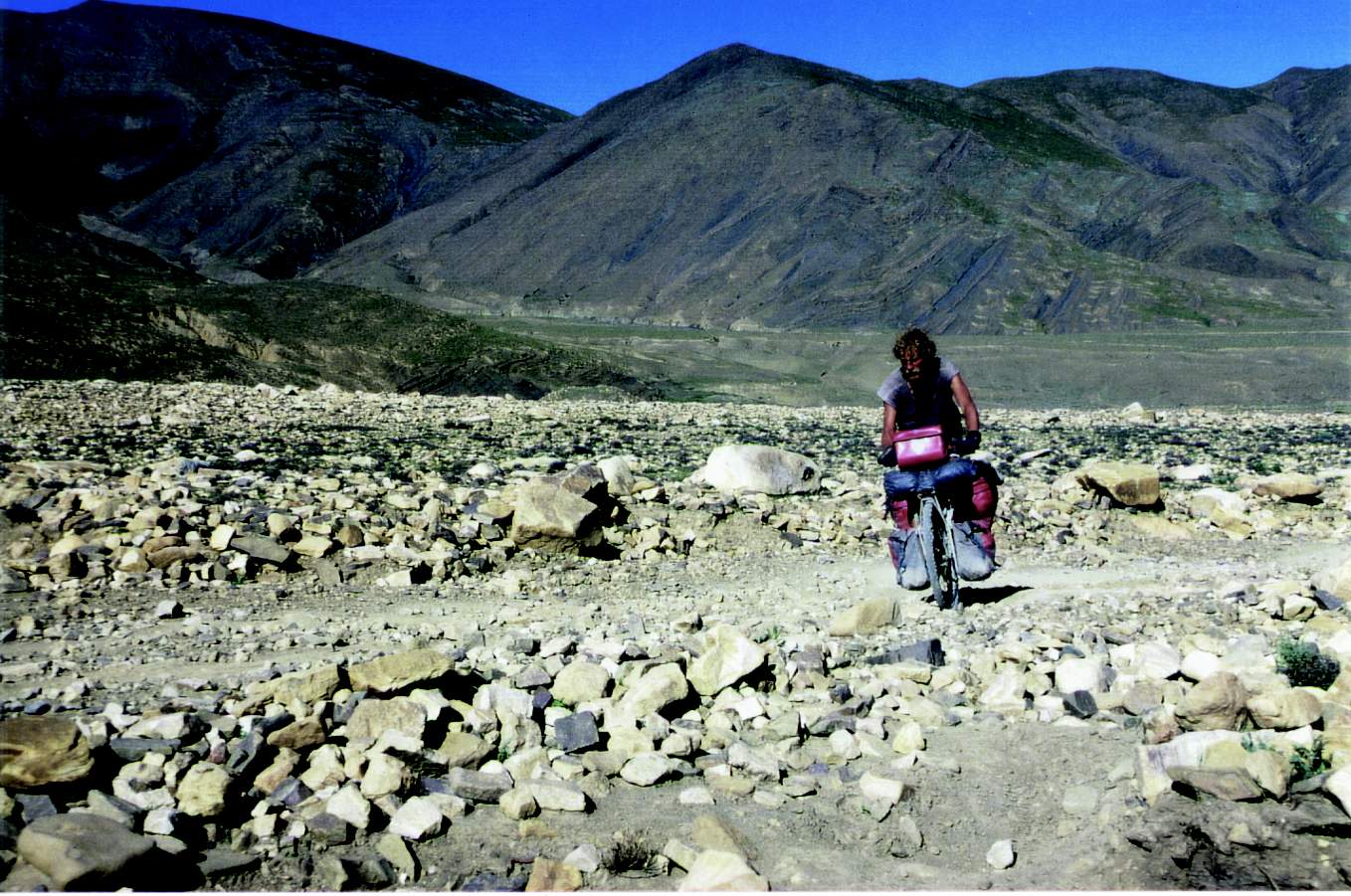
But of course the classic Bikepacking bags also have their limitations. Mostly in terms of space, the way they are attached and/or practical accessibility.
For this reason, carrier systems are becoming more popular again. Why have to fasten and strap in complicated ways when you can just hang on? Why have to stuff gear in a messy way when you have better accessibility and overview with a bag?
Don’t misunderstand: classic Bikepacking bags have their purpose and justification, of course, and I’m more of a Team Bikepacking bag person myself. But diversity also means being open to alternatives, especially if they can offer more comfort and ease of use.
Solutions like the front rack Jack the Bikerack or the mobile Ortlieb Quick Rack offer more options and possibilities to carry luggage and not get into trouble even when riding off-road. However, racks always have a few “weak points”: the stability of the rack on the bike and with panniers off-road, the impact on handling and, of course, aerodynamics.

And how these three disadvantages can be eliminated is demonstrated by Tailfin and its now very well-known carrier and bag system. The developers from Bristol/UK come from a sporting background and in their development have primarily focused on use in races and more ambitious Bikepacking tours.
This also explains the increasing visibility of the Tailfin System at ultra bikepacking races in recent months. At the Silk Road Mountain Race in 2022, for example, 20% of the participants were already riding with Tailfin. At the Atlas Mountain Race 2023 it was 15% (compared to 11% in 2022) and at the Hellenic Mountain Race 15% also used the system from Bristol.
And the data also speak for themselves: according to an aero test by Francis Cade, you can see very well the air resistance effects of different bag systems in watts and their effects. At first glance, this is only relevant for sporty cyclists, but it also shows the average cyclist how much power can be saved with different systems.

The Tailfin Aeropack in practice
But why do many “pros” rely on the Tailfin carrier system, when it is heavier than conventional saddlebags?
Sebastian Breuer, winner of Badlands 2022, European & German Champion MTB 2021 and well-known gravel race rider, also relies on Tailfin and rides for the R&D team of the British company.
Sieh dir diesen Beitrag auf Instagram an
When I asked him why he uses Tailfin, he said that it gives him a more stable ride and that he disliked the swinging back and forth of classic saddlebags. In addition, classic saddlebags are harder to pack, whereas the Tailfin can be taken down super fast and can be loaded or unloaded very quickly. For Sebastian, this makes it much more efficient for races. And the extra weight is more than compensated for by the advantages of the Tailfin.
I have been watching Tailfin with interest for a long time and have observed how the system is spreading, especially among ultra riders. The reasons for this are Tailfin’s race focus and, to be honest, the very good development and quality of the products.
I was therefore pleased to finally be able to test the system.
I chose the Carbon AeroPack with pannier mount and the matching Tailfin Mini Pannier in 5L and 10L sizes.
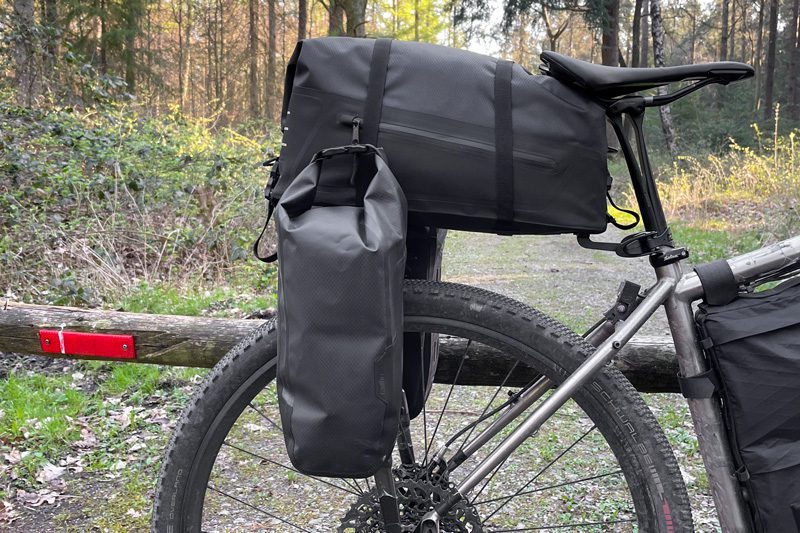
Before I look at the individual bags in detail, an overview of the Tailfin range and concept:
Tailfin is best known for its racks. These racks are available individually or in combination with a bag, the AeroPack system.
The bag alone is called AP20 Trunk Top Bag and is combined with a Tailfin rack. Here, the bag can be easily attached and detached.

However, Tailfin recommends the AeroPack combination for Bikepacking, where the bag is firmly bolted to the rack.
Personally, I find the first combination of separate rack and bag more practical for my way of Bikepacking, as I then have my sleeping things in the bag, for example, and like to take them with me to the tent or lodging. And the bag can also be packed and compressed better separately.
But: the fixed version, called AeroPack, can also be removed from the bike in seconds (or put back on again), making it easier to pack the bag and take it to camp.
For the test, I chose the Tailfin Carbon AeroPack, i.e. the version where the bag is firmly screwed to the top. With the rack and the AeroPack, there is a choice between with or without pannier mounts. In other words, you can decide whether you only want to mount the bag on top of the rack or whether you also want to mount bags on the side.
I opted for pannier mounts, because this turns the Tailfin into a modular system for all kinds of tours, with which you can react flexibly to luggage volumes and requirements. Either slim and elegant in summer with just the AeroPack, or in winter or on a longer tour with more luggage requirements with the Mini or Super Light Panniers.

When it comes to the carrier material, you can choose between aluminium and carbon. Ultimately, it’s a question of weight and price. But if you choose the aluminium version, the carrier comes with eyelets on the right and left, to which you can then attach either bottle cages or Anything Cages/Ortlieb Fork Packs. You can’t do that with the carbon version.
Let’s go back to the tailfin bags: the British have recently expanded their range considerably. In addition to the AeroPack rack bag, there is the Super Light Pannier, which is reminiscent of classic panniers. And the so-called Mini Pannier, which is available in 5L and 10L versions.
And I can already say: the fastening of the Mini Panniers and the workmanship are excellent. They can be attached very quickly and merge with the AeroPack to form a unit that is very stable and aerodynamic.
In addition, Tailfin offers other bag systems for mounting on the fork and down tube, which you should also take a look at. Especially the solutions for suspension forks. And if you believe the pictures and rumours, there will soon be a frame bag and handlebar bag from Tailfin.
What started out as a rack and bag has now developed into a comprehensive and high-quality all-round Bikepacking range.
The Tailfin bags in detail
Tailfin Carbon AeroPack with Pannier Mounts

It takes a bit of screwing, but after a few minutes everything is ready and the bow is screwed to the bag and at the bottom to the clamps for the axle. The instructions are very intuitive and easy to understand.
There are three ways to attach the Tailfin Carbon AeroPack:
- Attachment to the thru axle with Fast Release
- Attachment to the frame with Fast Release
- Attachment to the frame
I chose to attach the AeroPack to the thru axle. There are different types of axles from which you can choose the one that suits your bike. If you are unsure, the Tailfin Support will help you.
This Tailfin thru axle protrudes on both sides. The Fast Release is then mounted there. This is a rather interesting system that is simply placed around the axle and clicked into place. To release, you simply pull the pin. The whole thing is very stable and, of course, does not come loose while riding.
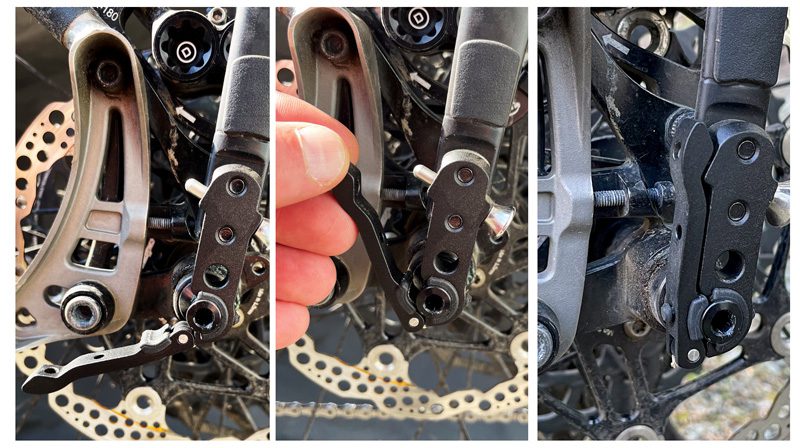
Then the AeroPack is attached to the seat post. It doesn’t matter whether it is made of carbon or aluminium (or titanium). The fastening is done via a clamp connection that tightens a rubber and keeps it under tension. Here too, the quality of the fastening is very high and the system works perfectly, even off-road, loaded and when riding hard.
The attachment of this saddle clamp can also be extended if you have or need a little more space. Then it pushes the bag away a bit towards the back. And if you need a little more rubber for the seatpost: a longer strap is included.
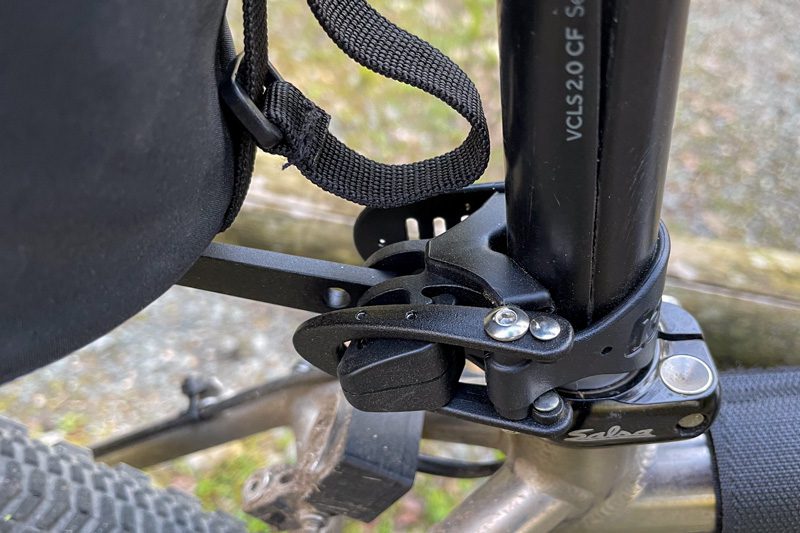
Once installed, the bag should be mounted halfway horizontally with a slight inclination towards the saddle. You can orientate yourself on the pictures in the assembly manual.
The material of the AeroPack bag (the AP20 Trunk Top Bag) is made of a laminated fabric that is welded and 100% waterproof. It has a length of 430mm and is approx. 160mm wide at the back and approx. 130mm wide at the front towards the saddle.
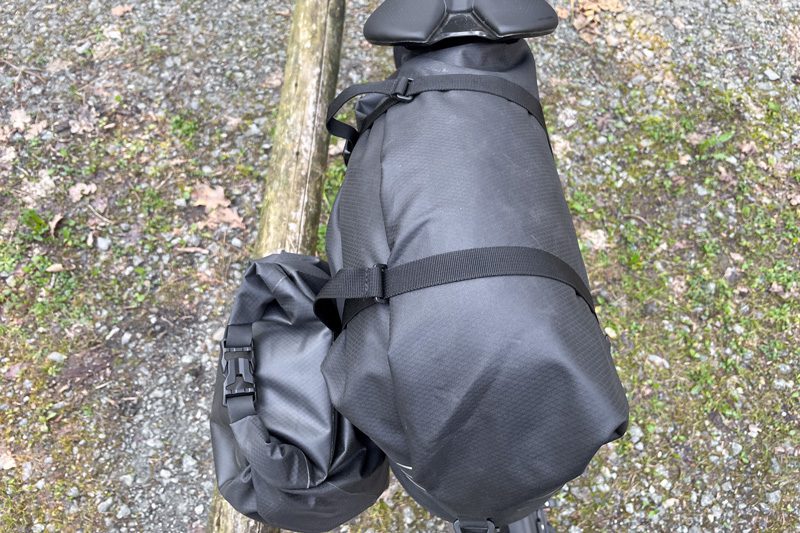
It has a roll-up closure which is closed by click fasteners at the front and back. Here’s my note that these fasteners only go in one direction, so they don’t go into each other randomly, they just go in one way. That’s okay, but you have to keep that in mind when rolling them up.
In addition, the bags are then additionally closed by two straps attached to the sides. These are also useful for attaching additional stuff to the top of the bag.
They are also closed with a click closure and can then be adjusted for compression.
The bag has a volume of 20 litres, which is quite a lot. I was able to stow my sleeping bag, sleeping pad, inner sleeping bag, merino leggings and long sleeve, socks, down jacket, wash kit and towel in it.
By the way – since the question came up: I usually stuff my sleeping bag into the respective pack sack. With the Tailfin, I stuffed it into its original pack sack and then put that into the AeroPack. Basically like Tetris with all the other stuff. Of course, you can also stuff the sleeping bag directly into the AeroPack as usual, but that didn’t seem so practical to me.
For packing, you can just leave the AeroPack on the bike. However, I usually took it off and put it on the ground, as it was easier to compress that way. The rack bracket can simply be folded down for this purpose. Of course, you should not exert too much pressure from above when compressing – especially not with the carbon version.
When packing, according to Tailfin, you should make sure to stow heavier items towards the front, towards the seat post. You should also bear in mind that, depending on the bike, the space under the saddle may be limited and the height of the pack may be reduced accordingly.

In addition to the main compartment, there are two zips on each side. One is for a separate and flat side pocket. This can be used to store a multitool or bars and gels. On the other side, the zip opens the main compartment and you can access the bag directly. I also put toilet paper and cream in there.
According to Tailfin, the weight of the Carbon AeroPack with Pannier Mounts is 850g, weighed in at 870g. The price for this version is 510 euros.
Tailfin Mini Pannier 5L & 10L

If you choose a rack with a pannier mount, you can attach the Tailfin Mini Pannier. These are narrow panniers similar to the Ortlieb Fork Pack, which are clamped to the pannier mount of the Tailfin rack by means of a high-quality clamping mechanism operated by a lever.

The principle works so simply that it is possible to remove or clamp a Mini Pannier within seconds. And the bag is then held absolutely securely on the rack, additionally fixed by a clamp at the bottom of the rack. Nothing wobbles.

The Mini Pannier bags have a roll closure that is secured by a click lock. Additional straps are included in the scope of delivery to offer alternative closure options on the right and left sides. In addition, straps can also be attached at the top and bottom to offer the possibility of attaching other items to the outside of the panniers.

And the best thing is: the Mini Panniers can also be mounted on conventional luggage racks. Appropriate spacers – if needed – are included.
With the Mini Panniers, the space offered by the Tailfin system is considerably increased. On my spring tour into the Stone Age, I used them to transport clothes and food. On the MainFranken Graveller my bivouac sack.

The 10L Panniers already offer a lot of space and are, in my opinion, a good offer for all those who also want to do long tours where a little more space is needed. The smaller 5L version is a great addition for more minimalist Bikepacking, where you might need a little more storage space in winter. But even here you can fit a lot in.

The 5L Mini Pannier is 380mm high and measures about 170mm wide at the top and 110mm wide at the bottom. In depth, they measure 70mm at the bottom and 120mm at the top, according to Tailfin.
The weight of the 5L Mini Pannier is 310g according to Tailfin, reweighed 339g (per bag). The maximum load is stated as 4kg for off-road tours. If it’s just going on the road, then 8kg is allowed.

The 10L version measures 400mm in height and is 210mm wide at the top and 140mm wide at the bottom. The depth is 150mm at the top and 110mm at the bottom, which is slightly more than the smaller version.
According to Tailfin, the weight is 380g, after weighing 419g. The maximum load recommendations of 4 and 8 kg depending on the route requirements also apply here.
The price for the 5L version is 75 euros, the 10L version costs 100 euros (per bag).

Like the AeroPack, the Mini Pannier is made of Hypalon/Ripstop Nylon and is 100% waterproof. They are also abrasion resistant. I’ve had quite a few passages and places where the bags have been stressed. But none of these challenges left permanent marks.
Conclusion Tailfin AeroPack: Lightweight with lots of storage space

I am taken with the simplicity, workmanship and quality of the detail solutions and the high value of Tailin. I particularly like the modular system with the Mini Panniers behind it, which meets every requirement for Bikepacking or cycle touring. I can take part in challenging Bikepacking races as well as go on an extended bike trip.
So it’s not just a system for sporty, ambitious and professional gravel riders for whom aero is particularly important, but for anyone who travels by bike.
The system is aerodynamic, offers a high level of riding comfort, is easy to use, absolutely waterproof and very stable.
In terms of handling, the carrier system does not stand out. On the contrary, the usual agility and mobility are maintained. This speaks for the stability of the system. I even forgot that I had the Tailfin AeroPack on while riding and only noticed it when I got off.
In practice, the AeroPack is also resistant enough to withstand a fall or an overturn. You don’t have to treat it like a raw carbon egg, but can work with it normally.

But…
…with some frames/bikes the tailfin can lead to wobbling. This only happened to me when I was riding freehand. Then the front wheel swung up. But I only had this effect when I had the Mini Pannier mounted. The AeroPack on its own had no effect on me. However, Tailfin already knows about this phenomenon, has experienced it himself and was very open to me and interested in feedback. As written, this phenomenon probably only occurs in a few cases. I also contacted other Tailfin riders and asked them about it. One of them had the same experience. One solution is to pack the luggage differently, for example, with the heavy things more towards the front of the saddle.
However, I also know this bouncing from my bike touring days, where it was caused by incorrect loading, flex of the touring bike frame and the rack or imbalances in the tyres – at that time, however, even with both hands on the handlebars. So I was already familiar with this phenomenon, but I was surprised that it only occurred with the Tailfin when I was free-handed and that otherwise nothing could be felt or noticed when riding. So it doesn’t affect the normal riding behaviour. Only when riding hands-free.
What is the difference between the Tailfin AeroPack and a normal Bikepacking saddle bag?

In my opinion, the Tailfin AeroPack system should not only be compared with normal Bikepacking saddle bags, but rather with other carriers and the corresponding bags.
For example, the Ortlieb Quick Rack Light (440g) in combination with the Gravel Packs (2x 580g with 2x 12.5L volume) weigh a total of 1,600g compared to the Tailfin AeroPack with 870g and 20L volume.
However, the price of the Tailfin system is an issue that cannot be left out. While the Ortlieb system mentioned above costs only 220 euros, the carbon version of the Tailfin AeroPack costs more than twice as much (510 euros). And even the aluminium version of the AeroPack costs 410 euros, which is almost twice as much.
On the other hand, the carbon version of the Tailfin AeroPack without pannier mounts weighs between 720g and 770g (depending on the mounting method) and offers 20L of volume. Some Bikepacking saddlebags are not far behind and weigh 600g and more, with less volume.
Apart from the visual differences, the following factors distinguish Tailfin from classic Bikepacking saddlebags:
- Aerodynamics factor: The Tailfin AeroPack is aerodynamically optimised and thus offers less air resistance compared to classic systems. This leads to higher efficiency at high speeds or on long distances.
- Stability factor: The Tailfin system is designed to offer greater stability than classic Bikepacking systems. This means that the luggage remains securely and stably attached to the bike, which is particularly advantageous on uneven terrain. But this is also the case with classic Bikepacking bags, such as the Revelate Designs Spinelock saddle bag or the Ortlieb Seat-Pack QR. However, I have to point out the swing-up effect in my case, as described above.
- Weight factor: The Tailfin AeroPack Carbon is made of lightweight carbon and weighs less compared to classic carrier systems, as explained above. This can reduce the overall weight of the bike, which can be an advantage especially on longer tours or races. Of course, classic Bikepacking saddlebags are lighter, but have less capacity and also offer fewer aerodynamic and stability advantages. Nevertheless, they are sometimes the right choice, especially if not so much volume is needed.
- Factor easy assembly: The Tailfin AeroPack can be easily and quickly attached to the bike within seconds, without the need for additional accessories or tools. This is a clear advantage over classic saddle bags (ass rockets). However, the Ortlieb Quick Release rack is almost as quick to mount.
- Versatility factor: The Tailfin AeroPack can be used both as a saddle bag and as a carrier, offering greater flexibility than classic Bikepacking systems. With the corresponding pannier, a saddle bag here quickly becomes a complete bag system with correspondingly large volume. In addition, the AeroPack is also suitable for dropper posts/adjustable seat posts.
But which is better?
There is no clear answer to the question of which is better, the Tailfin or the classic saddlebag/ass rocket.
Tailfin has advantages that will appeal to performance-oriented bikepackers who are looking for a system that is modular and can be expanded as required without having to compromise on riding performance. The Tailfin system is better in aerodynamics, eliminates the loss of efficiency and the poorer ride feel that comes with a moving saddlebag. However, there are already systems (Revelate Spinelock, Ortlieb Seat-Pack QR) that completely eliminate this and a well-packed and mounted saddlebag has never wobbled for me, whether Apidura, Brooks, Ortlieb, Revelate or Decathlon. But a certain amount of movement always remains, of course.

So saddlebags have their fixed and rightful place. In comparison, the price and the weight speak for them. And brands like Cyclite and Apidura show that classic systems can also be convincing in the performance area, especially with their low weight compared to the Tailfin. However, they are less easy and quick to mount and may have disadvantages in terms of aerodynamics. It’s up to you to decide whether you notice this and whether it’s important to you.
But you don’t always need 20 litres of volume on your bike. Sometimes you just need a small saddle bag with a few litres and then a Tailfin AeroPack is simply too much of a good thing and not the right choice in terms of weight and space.
At the end of the day, the decision pro or contra Tailfin will be a question of budget.
Personally, I am mixed. I find the Tailfin system very attractive because it offers me a very good and optimal system with which I can do my races but also go on Bikepacking tours.
I am used to classic Bikepacking systems and get along very well with them. Overall, these are lighter for me and I have to consider whether the system advantage and the advantage in aerodynamics and riding characteristics are worth the higher budget. And sometimes I don’t need as much volume as Tailfin offers.
In any case, the Tailfin system saves me a front roller, for example, and that in turn saves me a lot of energy, because there’s nothing in the wind at the front except my two bottles on the fork.
So in the end it’s up to you and your demands, preferences and possibilities.
In any case, you get a lot for your money and above all a very high-quality and flexible carrier system with which you are prepared for everything.
And if it helps you: the money is not gone, just somewhere else.





